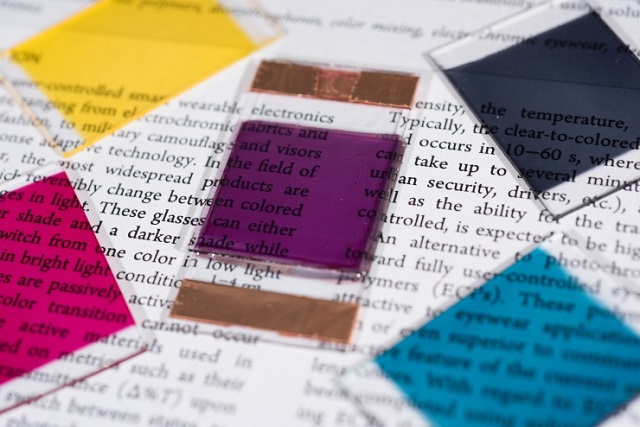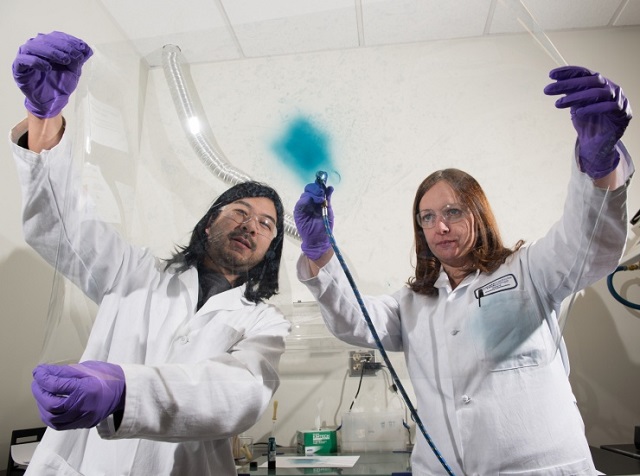 Samples show some of the colors researchers have produced in electrochromic polymers. The materials can be used for applications such as sunglasses and window tinting that can be turned on and off through the application of an electrical potential. (Credit: Rob Felt)
Samples show some of the colors researchers have produced in electrochromic polymers. The materials can be used for applications such as sunglasses and window tinting that can be turned on and off through the application of an electrical potential. (Credit: Rob Felt)
Researchers at the Georgia Institute of Technology, along with support from BASF, have developed a broad color palette of electrochromic polymer materials that can be used for tinting windows, sunglasses and other such applications that are dependent upon an electric current for producing color changes.
The research team has covered the color spectrum, by creating electrochromic polymer materials in primary and secondary colors and also by combining them in particular blends. The researchers have also developed four shades of brown, which is quite difficult to achieve. When used in sun glasses, the tint would change to clear state within seconds when a button is pressed. These electrochromic polymer materials can also be used for making greeting cards, signage and window tinting that change in color when a low-voltage electrical current is applied.
This study was performed in the laborastory of John Reynolds. Reynolds is a professor in the School of Chemistry and Biochemisty and the School of Materials Science and Engineering at the Georgia Institute of Technology.
We’ve demonstrated the ability to create virtually any color we want by mixing different electrochromic polymers, just like mixing paint. Using a simple coating method or even inkjet printing, we can create films that change color with the application of a voltage.
Anna Österholm, a research scientist in Georgia Tech’s School of Chemistry
Over the years, the researchers at Reynolds’ lab have developed many colors such as cyan, orange, green, magenta, yellow, and blue polymers, and these can be dissolved in ordinary solvents. Furthermore, the polymer solutions can be blended to achieve specific colors.
The researchers created a five-layer sandwich of materials that was made up of an electrochromic material film, a UV-curable electrolyte, a charge storage layer, and anode and cathode layers.

Georgia Tech researchers Eric Shen and Anna Osterholm demonstrate how films of electrochromic polymers can be applied to large surfaces. Image Credit: Rob Felt
A short pulse of electrical current is sufficient for switching the lenses between colored and colorless states. A continuous power supply is not required. When a colorless state is to be maintained, a refresh pulse has to be applied in about every 30 minutes for a brief period. The colored state has the ability to remain stable for many days. Within a few seconds, the materials can switch between 10% transmittance and 70% transmittance.
When yellow and cyan primary colors are combined with periwinkle-blue and orange secondary colors, brown shades can be created.
Photochromic sunglasses which are currently in the market become dark due to a silver halide reaction that responds to light. However, many of these photochromic sunglasses react to ultraviolet wavelengths. Automobile windshields filter out these wavelengths, and hence the photochromic sunglasses take several minutes to respond and transition from their states. Users cannot control them. Drivers, pilots and other personnel who have to move swiftly between dark and light environments will face problems due to the passive switching time.
In contrast, by using electrochromic polymers, we can create devices that by pushing a button, can be converted from dark to clear. They are completely user-controlled, and it doesn’t matter whether they are being used indoors or outdoors, in a vehicle or an aircraft.
Österholm
A simple coin battery provides an electrical potential that triggers a reduction-oxidation reaction in electrochromic materials. An application of a -1V makes the glasses switch to color while, a +1V makes the glasses become clear. “Essentially, we are just charging and discharging the device, which is what causes the color change,” explained Eric Shen, a postdoctoral fellow in the Georgia Tech School of Chemistry and Biochemistry.
The Reynolds Laboratory had been conducting research on synthesizing polymers that had repeat-unit structures that in turn provided the palette of colors. These electrochromic materials are the fruit of these efforts. These materials can be dissolved in the same solvents which allow creation of additional colors by mixing particular quantities of both primary and secondary colors.
Anything that you would want to have change color at the push of a button would be an application for these. We have shown that we can switch them on and off thousands of times, and that we can shine strong light on them without causing degradation of the color.
Eric Shen, a postdoctoral fellow in the Georgia Tech School of Chemistry and Biochemistry
In order to produce films using these colorful materials, the team utilized blade and spray-coating techniques. Currently, the research team is using ink-jet printing for creating patterns and also mixing the polymers to produce colors.
The ink-jetting is very versatile when you want to make patterns or very fine features with these materials. The fact that the polymers are so soluble makes it quite easy to process them using anything that would spread an ink.
Eric Shen, a postdoctoral fellow in the Georgia Tech School of Chemistry and Biochemistry
The other co-authors of this study include Michael Kuepfert from BASF, Rayford Bulloch and Justin Kerszulis from Georgia Tech, and Aubrey Dyer from Clayton State University.
This study titled “Four Shades of Brown: Tuning of Electrochromic Polymer Blends Toward High-Contrast Eyewear,” has been published in ACS Applied Materials & Interfaces.
References